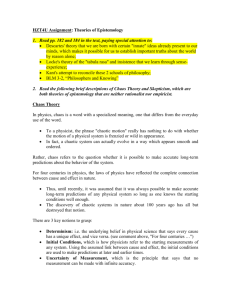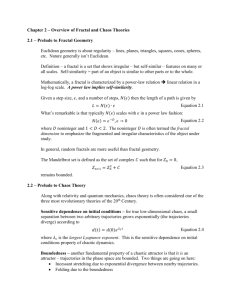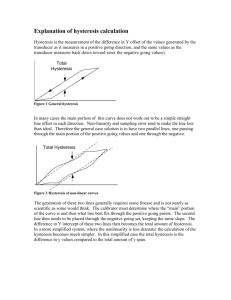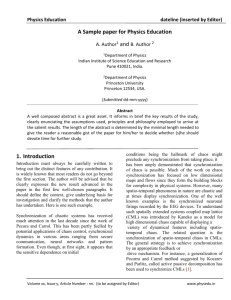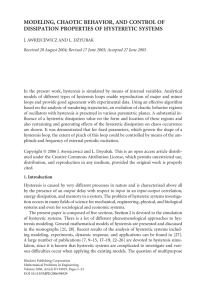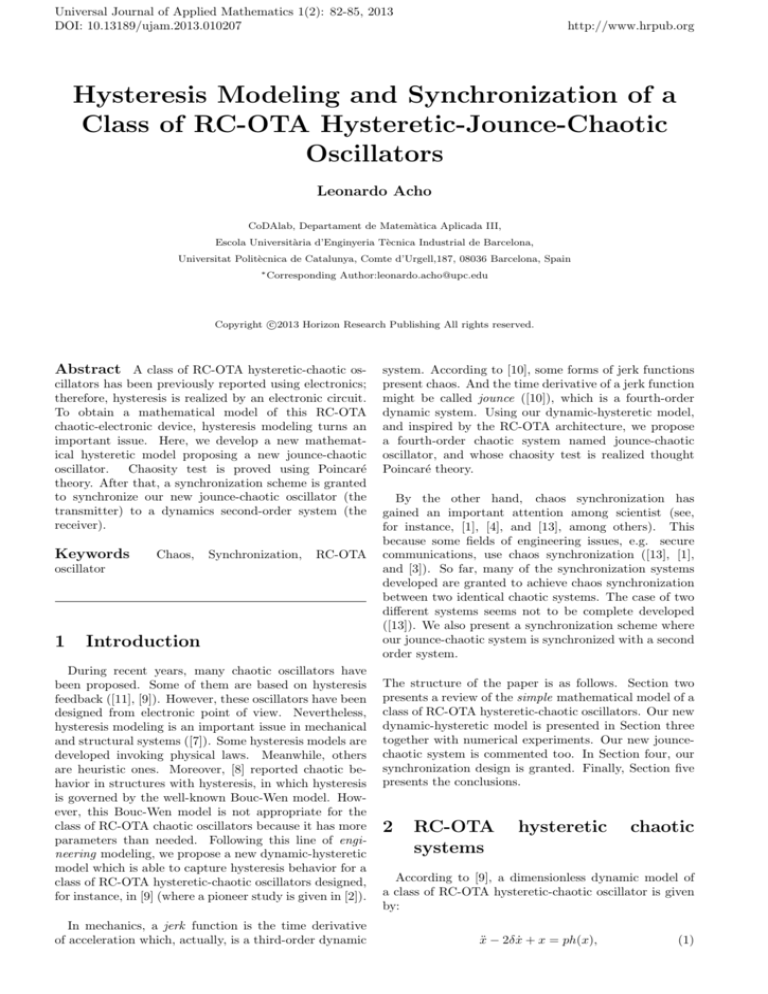
Universal Journal of Applied Mathematics 1(2): 82-85, 2013
DOI: 10.13189/ujam.2013.010207
http://www.hrpub.org
Hysteresis Modeling and Synchronization of a
Class of RC-OTA Hysteretic-Jounce-Chaotic
Oscillators
Leonardo Acho
CoDAlab, Departament de Matemàtica Aplicada III,
Escola Universitària d’Enginyeria Tècnica Industrial de Barcelona,
Universitat Politècnica de Catalunya, Comte d’Urgell,187, 08036 Barcelona, Spain
∗ Corresponding
Author:leonardo.acho@upc.edu
c
Copyright ⃝2013
Horizon Research Publishing All rights reserved.
Abstract A class of RC-OTA hysteretic-chaotic oscillators has been previously reported using electronics;
therefore, hysteresis is realized by an electronic circuit.
To obtain a mathematical model of this RC-OTA
chaotic-electronic device, hysteresis modeling turns an
important issue. Here, we develop a new mathematical hysteretic model proposing a new jounce-chaotic
oscillator.
Chaosity test is proved using Poincaré
theory. After that, a synchronization scheme is granted
to synchronize our new jounce-chaotic oscillator (the
transmitter) to a dynamics second-order system (the
receiver).
Keywords
Chaos,
Synchronization,
RC-OTA
oscillator
1
Introduction
During recent years, many chaotic oscillators have
been proposed. Some of them are based on hysteresis
feedback ([11], [9]). However, these oscillators have been
designed from electronic point of view. Nevertheless,
hysteresis modeling is an important issue in mechanical
and structural systems ([7]). Some hysteresis models are
developed invoking physical laws. Meanwhile, others
are heuristic ones. Moreover, [8] reported chaotic behavior in structures with hysteresis, in which hysteresis
is governed by the well-known Bouc-Wen model. However, this Bouc-Wen model is not appropriate for the
class of RC-OTA chaotic oscillators because it has more
parameters than needed. Following this line of engineering modeling, we propose a new dynamic-hysteretic
model which is able to capture hysteresis behavior for a
class of RC-OTA hysteretic-chaotic oscillators designed,
for instance, in [9] (where a pioneer study is given in [2]).
In mechanics, a jerk function is the time derivative
of acceleration which, actually, is a third-order dynamic
system. According to [10], some forms of jerk functions
present chaos. And the time derivative of a jerk function
might be called jounce ([10]), which is a fourth-order
dynamic system. Using our dynamic-hysteretic model,
and inspired by the RC-OTA architecture, we propose
a fourth-order chaotic system named jounce-chaotic
oscillator, and whose chaosity test is realized thought
Poincaré theory.
By the other hand, chaos synchronization has
gained an important attention among scientist (see,
for instance, [1], [4], and [13], among others). This
because some fields of engineering issues, e.g. secure
communications, use chaos synchronization ([13], [1],
and [3]). So far, many of the synchronization systems
developed are granted to achieve chaos synchronization
between two identical chaotic systems. The case of two
different systems seems not to be complete developed
([13]). We also present a synchronization scheme where
our jounce-chaotic system is synchronized with a second
order system.
The structure of the paper is as follows. Section two
presents a review of the simple mathematical model of a
class of RC-OTA hysteretic-chaotic oscillators. Our new
dynamic-hysteretic model is presented in Section three
together with numerical experiments. Our new jouncechaotic system is commented too. In Section four, our
synchronization design is granted. Finally, Section five
presents the conclusions.
2
RC-OTA
systems
hysteretic
chaotic
According to [9], a dimensionless dynamic model of
a class of RC-OTA hysteretic-chaotic oscillator is given
by:
ẍ − 2δ ẋ + x = ph(x),
(1)
Universal Journal of Applied Mathematics 1(2): 82-85, 2013
83
where δ and p are the system parameters. The hysteresis
function h(x) is shown in Fig. 1. This system presents
chaos with δ = 0.05, and p = 1 ([9]).
Figure 3. Simulation result.
Figure 1. Normalized hysteretic function.
3
Hysteresis modeling and
jounce-chaotic system
a
Hysteresis behavior is recognized as a system with
memory. One way to capture hysteresis is by using a
dynamic system. For instance, the new hysteretic system:
ż = α(−z + bsgn(x + asgn(z))),
(2)
can reproduce the hysteretic behavior shown in Fig. 2,
where a and b are the hysteresis curve parameters. The
speed transition between b and −b is governed by the
positive parameter α; sgn(·) is the signum function. For
instance, if a = b = 1 and α = 10, the system (2) is:
Figure 4. Chaotic attractor with initial conditions x(0) = ẋ(0) =
0 and z(0) = 0.1.
(3)
ẋ1
ẋ2
= x2 ,
= z1 + z2 + 0.1x2 − x1 ,
Using x = 10sin(t) and z(0) = 0, the simulation result
of system (3) is shown in Fig. 3.
ż1
ż2
= 10(−z1 + sign(x1 − 1 + sign(z1 )) + 0.5), (6)
= 10(−z2 + sign(x1 + 1 + sign(z2 )) − 0.5). (7)
ż = 10(−z + sgn(x + sgn(z))).
Next, we program a chaotic oscillator equivalent to (1):
ẍ
ż
−0.1ẋ + x = z
= 10(−z + sgn(x + sgn(z))).
Fig. 4 shows the simulation result. The obtained
chaotic attractor is the same as that shown in [9, Fig.
6].
(4)
(5)
Figures 5 and 6 show the jounce-chaotic attractor of the
system (4)-(7). Fig.7 shows the Poincaré map for the
attractor shown in Fig. 6 using the Poincaré section a
plane parallel to the plane z1 -x2 and located at x1 = 1.
According to [12], this map consists of points filling up a
region implying chaos. So, this Poncaré-map experiment
is our chaosity test to our jounce-chaotic system. By the
other hand, Fig. 8 displays x1 (t) and x2 (t) versus time.
With a small change on the initial condition of x1 from 0
to 0.001 (the remaining initial conditions were the same
than the previous numerical experiment), the numerical
results are displayed in Fig. 9. We thus have a dynamic
system that presents bounded trajectory solutions that
is highly sensitive to initial conditions and whose signals
are random-like. These are the properties of a chaotic
system.
4
Synchronization
Let us introduce the following system:
Figure 2. Hysteretic behavior.
To extend the previous system into a jounce-chaotic realization, consider the next propose:
ẏ1
= y2 ,
(8)
ẏ2
= z1 + z2 + 0.2x2 − y1 − 0.1y2 ,
(9)
84
Hysteresis Modeling and Synchronization of a Class of RC-OTA
Hysteretic-Jounce-Chaotic Oscillators
Figure 5.
Jounce-chaotic attractor with initial conditions
x1 (0) = x2 (0) = z1 (0) = 0 and z2 (0) = 0.1.
Figure 6. 3-D jounce-chaotic attractor.
Figure 8. Simulation results: x1 (t) and x2 (t) versus time.
Figure 9. High sensitivity test on the initial conditions: blue line
with x1 (0) = 0 and red line with x1 (0) = 0.001.
Figure 10. Synchronization block diagram.
y1 (0), x1 (0), y2 (0), and x2 (0))1 . This fact can be proved
as follows. Consider the signal errors given by
e1
e2
=
=
x1 − y1 ,
x2 − y2 .
Then, after some basic manipulations, we obtain:
Figure 7. Poincaré Map.
where z1 := z1 (t), z2 := z2 (t), and x2 := x2 (t) arrive
from the jounce-chaotic system (4)-(7). At this point,
the jounce-chaotic system (4)-(7) represents the transmitter and the system (8)-(9) the receiver. Fig 10 gives
a schematic representation of our the synchronization
design.
It is said that the receiver is synchronized with the transmitter if y1 (t) converges to x1 (t) and y2 (t) converges
to x2 (t) as time goes on (and for any initial conditions
ė1
= e2 ,
ė2
= −e1 − 0.1e2 .
The above system represents an exponential stable dynamics. Simulation results are shown in Fig. 11.
Remark 1 On synchronization of chaotic systems,
it is used to test the synchronization performance
by adding a noisy signal to the lines of the channel
communication. This noisy signal is a kind of common
noise because it is induced simultaneously on each
communication lines ([5]). But, from the technological
point of view, common noisy signals are easily to
remove via Instrumentation Amplifiers. For instance,
according to ([5], page 85), the common noise induced
1 Note
that signals z1 (t) and z2 (t) are bounded for all t ≥ 0.
Universal Journal of Applied Mathematics 1(2): 82-85, 2013
85
and Computers, Vol. 15, No. 4, 607–614, 2006.
[2] L. Acho, and Y. Vidal, Hysteresis modeling of a class
of RC-OTA hysteretic-chaotic generators, 4th International Conference on Physics and Control (PhysCon),
León, Spain, 2011.
[3] T.-L. Carroll, and L. M. Pecora, Synchronization
chaotic circuits, IEEE Trans. on Circ. Syst., Vol. 38,
453–456, 1991.
Figure 11. Simulation results with initial conditions x1 (0) =
x2 (0) = z1 (0) = 0, z2 (0) = 0.1, y1 (0) = 3 and y2 (0) = −3.
on the communication lines can be reduced 140dB;
i.e., it can be attenuate by a factor of 1014 . By the
other hand, employing fiber optics, noisy signals are
practically unnoticed on our communication system.
Remark 2 The communication scheme shown in Fig.
10 requires three lines of communication. However, it
is possible to implement a multiplexing communication
technique to drive a single line of communication (Website http://en.wikipedia.org/wiki/Multiplexing).
5
Conclusions
A new hysteretic-jounce-chaotic system has been designed along with a synchronization scheme. According to numerical experiments, chaos synchronization between two different systems can be achieved. This fact
was theoretically proved too.
Acknowledgements
This work was supported by grant number DPI201232375/FEDER from the Spanish Ministry of Economics
and Competitiveness.
REFERENCES
[1] L. Acho, Expanded Lorenz systems and chaotic secure
communication systems design,J. of Circuits, Systems,
[4] G. Chen, and X. Dong, From chaos to order: methodologies, perspectives and applications, World Scientific
Pu., Singapore, 1998.
[5] S. Franco, Design with Operational Amplifiers and Analog Integrated Circuits, McGraw-Hill, N.Y., USA, Third
Edition, 2002.
[6] H. Fengling, L. Jinhu, Y. C. Xinghuo, and C. Guanrong,
Dynamical behaviours of a 3D hysteresis-based system,
Chaos, Solitons and Fractals, Vol. 28, 182-192, 2006.
[7] M. Ismail, F. Ikhouane, and J. Rodellar, The hysteresis
Bouc-Wen model, a Survey, Arch. Comput. Methods
Eng., Vol. 16, 161–188, 2009.
[8] H. G. Li, and G. Meng, Nonlinear dynamics of a SDOF
oscillator with BoucWen hysteresis, Chaos, Solitons and
Fractals, Vol. 34, 337-343, 2007.
[9] S. Nakagawa, and T. Saito, An RC-OTA hysteresis
chaos generator, IEEE Trans. on Circuits and Systems1: Fundamental Theory and Applications, Vol. 43, No.
12, 1019–1021, 1996.
[10] J. C. Sprott, Some simple chaotic jerk functions, Am.
J. Phys., Vol. 65, No. 537, 537–543, 1997.
[11] M. Storace, and M- Parodi. Simple realisation of hysteresis chaos generator, Electronics Letters, Vol. 34, No.
1, 10–11, 1998.
[12] J. J.Thomsen, Vibrations and Stability: Advanced theory, analysis, and tools, Springer, Berlin, Germany, Second Edition, 2003.
[13] H. T. Yau, and J. J. Yan, Chaos synchronization of
different chaotic systems sibjected to input nonlinearity,
Applied Mathematics and Computation, Vol. 197, 775–
788, 2008.



